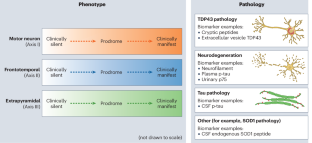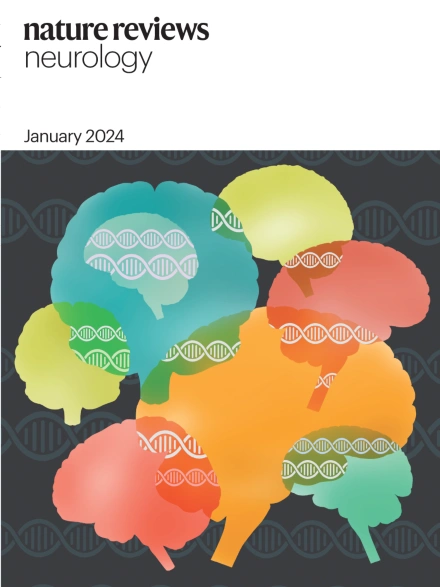The Miami Framework for ALS and related neurodegenerative disorders: an integrated view of phenotype and biology
IF 28.2
1区 医学
Q1 CLINICAL NEUROLOGY
引用次数: 0
Abstract
Increasing appreciation of the phenotypic and biological overlap between amyotrophic lateral sclerosis (ALS) and frontotemporal dementia, alongside evolving biomarker evidence for a pre-symptomatic stage of disease and observations that this stage of disease might not always be clinically silent, is challenging traditional views of these disorders. These advances have highlighted the need to adapt ingrained notions of these clinical syndromes to include both the full phenotypic continuum — from clinically silent, to prodromal, to clinically manifest — and the expanded phenotypic spectrum that includes ALS, frontotemporal dementia and some movement disorders. The updated clinical paradigms should also align with our understanding of the biology of these disorders, reflected in measurable biomarkers. The Miami Framework, emerging from discussions at the Second International Pre-Symptomatic ALS Workshop in Miami (February 2023; a full list of attendees and their affiliations appears in the Supplementary Information) proposes a classification system built on: first, three parallel phenotypic axes — motor neuron, frontotemporal and extrapyramidal — rather than the unitary approach of combining all phenotypic elements into a single clinical entity; and second, biomarkers that reflect different aspects of the underlying pathology and biology of neurodegeneration. This framework decouples clinical syndromes from biomarker evidence of disease and builds on experiences from other neurodegenerative diseases to offer a unified approach to specifying the pleiotropic clinical manifestations of disease and describing the trajectory of emergent biomarkers. In this Perspective, the authors propose a new classification system for amyotrophic lateral sclerosis and related neurodegenerative disorders that recognizes, in parallel, the clinical syndromes and the underlying biology of disease. The framework emerged from discussions at the Second International Pre-Symptomatic ALS Workshop in Miami (February 2023).


迈阿密渐冻人症及相关神经退行性疾病框架:表型与生物学的综合视角
人们越来越认识到肌萎缩侧索硬化症(ALS)和额颞叶痴呆症之间在表型和生物学方面的重叠,同时不断发展的生物标志物证据也证明了疾病的前症状阶段,并观察到这一阶段的疾病并不总是临床上无症状,这对这些疾病的传统观点提出了挑战。这些进展突出表明,有必要对这些临床综合征的根深蒂固的观念进行调整,使之既包括完整的表型连续体--从临床无症状到前驱期,再到临床表现--也包括 ALS、额颞叶痴呆和一些运动障碍的扩展表型谱。更新后的临床范例还应符合我们对这些疾病生物学特性的理解,并反映在可测量的生物标志物中。迈阿密框架是在迈阿密举行的第二届国际ALS前期症状研讨会(2023年2月;与会者及其所属机构的完整名单见补充信息)的讨论基础上形成的,该框架提出了一个分类系统:首先,三个平行的表型轴--运动神经元、额颞叶和锥体外系--而不是将所有表型要素合并为一个临床实体的单一方法;其次,反映神经变性的潜在病理学和生物学不同方面的生物标志物。这一框架将临床综合征与疾病的生物标志物证据分离开来,并借鉴了其他神经退行性疾病的经验,提供了一种统一的方法来明确疾病的多向临床表现,并描述新出现的生物标志物的轨迹。
本文章由计算机程序翻译,如有差异,请以英文原文为准。
求助全文
约1分钟内获得全文
求助全文
来源期刊

Nature Reviews Neurology
医学-临床神经学
CiteScore
29.90
自引率
0.80%
发文量
138
审稿时长
6-12 weeks
期刊介绍:
Nature Reviews Neurology aims to be the premier source of reviews and commentaries for the scientific and clinical communities we serve. We want to provide an unparalleled service to authors, referees, and readers, and we work hard to maximize the usefulness and impact of each article. The journal publishes Research Highlights, Comments, News & Views, Reviews, Consensus Statements, and Perspectives relevant to researchers and clinicians working in the field of neurology. Our broad scope ensures that the work we publish reaches the widest possible audience. Our articles are authoritative, accessible, and enhanced with clearly understandable figures, tables, and other display items. This page gives more detail about the aims and scope of the journal.
 求助内容:
求助内容: 应助结果提醒方式:
应助结果提醒方式:


